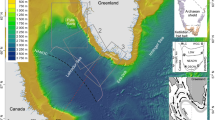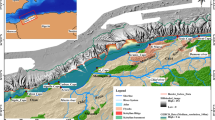Abstract
A dissected terrain resembling a shelf-edge canyon system with individual canyons up to 100 m in relief, 3 km in width, and 10 km in length is found along the south flank of the Cascadia Channel within the central Blanco Transform zone. The channels apparently formed from a combination of downcutting from turbidity currents off the Blanco Ridge and from backcutting due to mass-wasting. The relationships between the transform tectonics and the formation of the canyon are presented in a model which proposes both a direct link via triggering of slides from earthquakes and an indirect link associated with lowering the local base level of Cascadia Channel, thalweg downcutting, and wall-steepening leading to increased mass-wasting.
Similar content being viewed by others
References
McGregor BA, Stubblefield WL, Ryan WBF, Twitchell DC (1982) Wilmington submarine canyon: a marine fluvial system. Geology 10:27–30
LePichon XP, Renard V (1982) Avalanching: a major process of erosion and transport in deep-sea canyons: evidence from submersible and multi-narrow beam surveys. In: Scrutton RA, Talwani M (eds) The Ocean Floor. John Wiley & Sons, New York, pp 113–126
Malahoff A, Embley RW, Fornari DJ (1982) Geomorphology of Norfolk and Washington Canyons and the surrounding continental slope and upper rise as observed from DSRV ALVIN. In: Scrutton RA, Talwani M (eds) The Ocean Floor. John Wiley & Sons, New York, pp 99–111
Farre JA, McGregor BA, Ryan WBF, Robb J (1984) Breaching the shelfbreak; passage from youthful to mature phases in submerging canyon-evolution. In: Stanley DJ, Moore D (eds) Shelf to Slope Break. Society Economic Paleontologists Mineralogists Memoir 33 (in press)
Damuth JE, Kolla V, Flood RD, Kowsmann RO, Gorini MA, Monteiro MC, Palma JJC, Belderson RH (1983) Distributary channel meandering and bifurcation patterns on Amazon deepsea fan as revealed by long-range side-scan sonar (GLORIA). Geology 11:94–98
Anonymous (1978) Relief Map of Juan de Fuca Plate, Pacific Geoscience Centre and the Department of Energy, Mines, and Resources, Canada
Griggs, GB, Kulm LD (1970) Physiography of Cascadia deepsea channel. Northwest Science 44:82–94
Embley RW, Malahoff A, Ganse R (1984) Pull-apart basins along the Blanco Transform. American Association Petroleum Geologists Bulletin 68:474
Northup J (1970) Accuracy of earthquake epicenters on the Gorda Ridge. Bulletin Seismological Society of America 60:265–267
Johnson SH, Jones PR (1978) Microearthquakes located on the Blanco Fracture Zone with Sonobuoy arrays. Journal of Geophysical Research 83:255–261
Griggs GB, Kulm LD (1970) Sedimentation in Cascadia deepsea channel. Geological Society of America Bulletin 8:1361–1384
Griggs GB, Kulm LD (1973) Origin and development of Cascadia deep-sea channel. Journal of Geophysical Research 78:6325–6339
Griggs GB, Kulm LD, Waters AC, Fowler GA (1970) Deep-sea gravel from Cascadia channel. Journal of Geology 78:611–619
Ibach DH (1981) The structure and tectonics of the Blanco Fracture Zone. Masters of Science Thesis, Oregon State University
Prior D, Coleman J (1978) Disintegrating retrogressive landslides on very low-angle subaqueous slopes, Mississippi Delta marine. Geotechnology 3:37–60
Mammerickx J (1983) Deep-sea network of erosional channels. EOS 6:1032
Author information
Authors and Affiliations
Rights and permissions
About this article
Cite this article
Embley, R.W. A locally formed deep ocean canyon system along the Blanco Transform, Northeast Pacific. Geo-Marine Letters 5, 99–104 (1985). https://doi.org/10.1007/BF02233934
Received:
Revised:
Issue Date:
DOI: https://doi.org/10.1007/BF02233934




